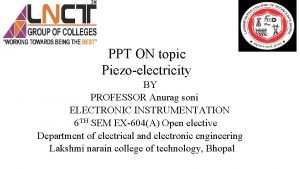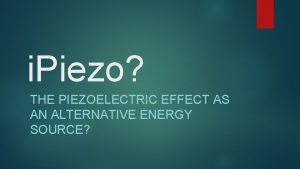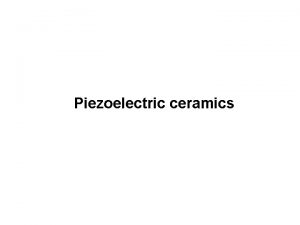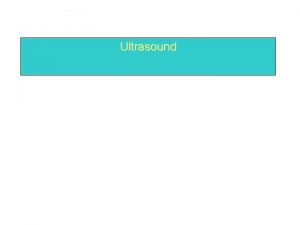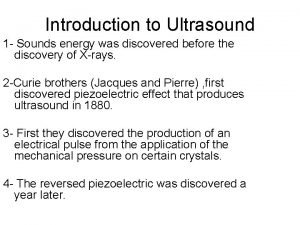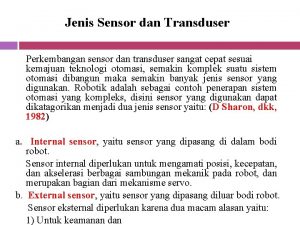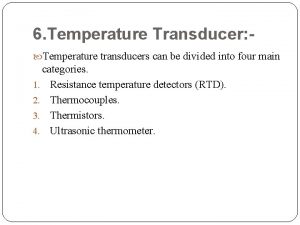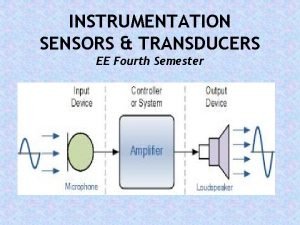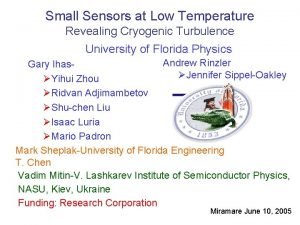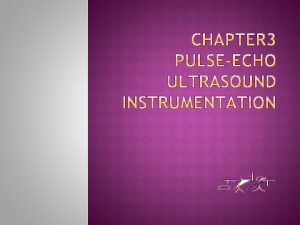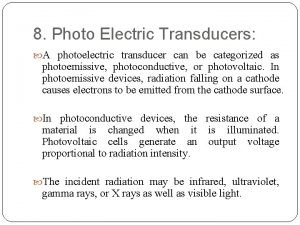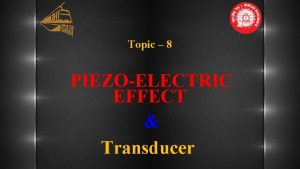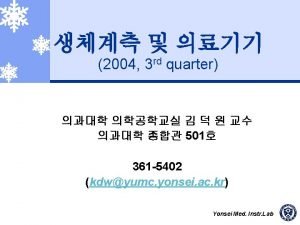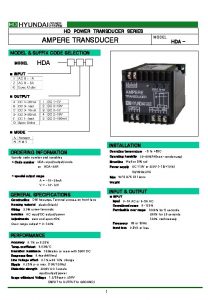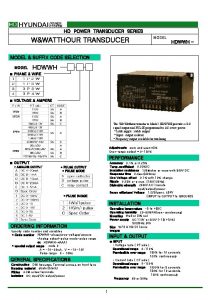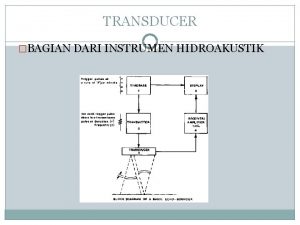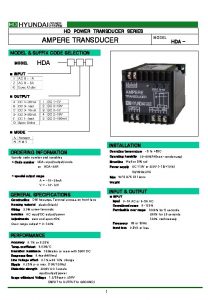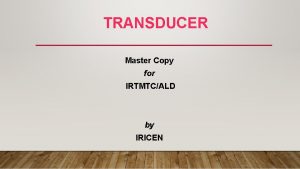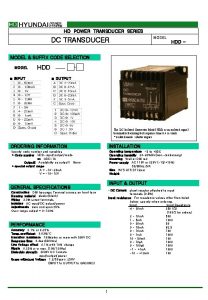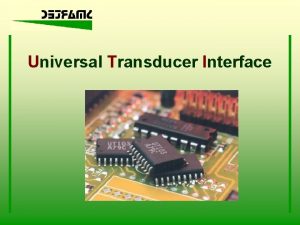Topic 8 PIEZOELECTRIC EFFECT Transducer Piezoelectric Effect 01














- Slides: 14

Topic – 8 PIEZO-ELECTRIC EFFECT & Transducer

Piezoelectric Effect 01: 35 § The Word piezo is derived from Greek word “PIEZIN” which means to squeeze or press. § The ability of certain materials, when they are subject to mechanical force (stress) an electrical charge (voltage) on their opposite faces of suitably cut planes develops, this phenomenon is known as the “Piezo-electric effect”. § The Piezo-electric Effect is vice-versa or reversible also. § The inverse Piezo-electric effect is used for generation of ultrasonic waves in the materials. § e. g. Quartz, tourmaline, lead zincronate, PVDC & piezocomposite crystals etc.

Transducer and Piezoelectric Transducer 01: 35 § Transducer is a device that convert one type of energy to another type for various purposes including measurement usually electrical, electronics, electrochemical etc. § The Transducer that convert electrical energy in to sound energy in ultrasonic range and vice-versa is known as Piezoelectric Transducer.

Piezoelectric Transducer 01: 35 § This electro-acoustic transducers are known as “PROBE” in ultrasonic field. § The piezo-electric effect provides a receiver for ultrasonic wave and the inverse effect is used for generating the ultrasonic wave in to the materials.

Transducers 01: 35 • The thickness of the active element is desired frequency of the transducer. determined by the • A thin wafer element vibrates with a wavelength that is twice its thickness. • Piezoelectric crystals are cut to a thickness that is ½ the desired radiated wavelength. • The higher the frequency of the transducer, the thinner the element active.

Transducers 01: 35 • To get maximum energy from transducer an impedance matchinglayerisplaced betweenactiveelementandtheface of the transducer. • Optimal impedance matching is achieved by sizing the matching layer so that its thickness is ¼ of the desired wavelength.

Transducers 01: 35 • This keeps waves that are reflected within the matching layer in phase when they exit the layer. • For contact transducers, the matching layer is made from a material that has an acoustical impedance between the active element and steel. • Immersion transducers have a matching layer with an acoustical impedance between the active element and water.

Transducers 01: 35 • Contact transducers also incorporate a wear plate to protect the matching layer and active element from scratching. • The backing material supporting the crystal has a great influence on the damping characteristics of a transducer. Using a backing material with an impedance similar to that of the active element will produce the most effective damping. • Such a transducer will have a wider bandwidth resulting in higher sensitivity and higher resolution.

Transducers 01: 35 • As the mismatch in impedance between the active element and the backing material increases, material penetration increases but transducer sensitivity is reduced. • The bandwidth refers to the range of frequencies associated with a transducer. The frequency noted on a transducer is the central frequency and depends primarily on the backing material. • Highly damped transducers will respond to frequencies above and below the central frequency.

Transducers 01: 35 • The broad frequency range provides a transducer with high resolving power. Less damped transducers will exhibit a narrower frequency range and poorer resolving power, but greater penetration.

§ Types of Piezo-Electric Crystals Natural Crystals Quartz (Si. O 2) Rochell salt (Sodium Potassium Tarterate) Tourmalline § Artificial or Synthetic Crystals (Ceramic Crystals) Barium Titanate (Ba. Ti. O 3) Lead Zirconate Titanate (PZT) – Mostly used for Manufacturing the Probes. Lithium Sulphate Lead Meta Niobate § Piezo polymers Polyvinylidene Fluoride or PVDF § Composites 1, 3 composite § Electromagnetic Acoustic Transducer (EMAT) 01: 35

Properties of Piezo-electric crystals & other Methods § Quartz • It has good physical, chemical thermal stability. • It requires high driving voltage at low frequencies, high acoustic impedance and low generate acoustic energy. It also suffers from mode conversion interferences. § Barium Titanate – It is poly crystalline ceramic material. It is unaffected by moisture. The impedance of this crystal is lower than quartz. It is usable of about 1300 C. 01: 35

Properties of Piezo-electric crystals & other Methods 01: 35 § Lithium Sulphate • It is very fragile and soluble in water. Its sensitivity is approx. 15 times more than the quartz. It is used for shorter acoustic pulse in case of pulse echo testing to locate flaw near to the surface. § Lead Meta Niobate – • The good results are not achievable due amount of interference between mode. The crystal is used for broad band, angle probe and TR probe. § Lead Zirconate Titanate (PZT) • This crystal is best generator of ultrasonic wave. Mode conversion is much less. It can be used to a maximum 3650 C. • This crystal is mostly used in Probes for Ultrasonic Testing.

Properties of Piezo-electric crystals & other Methods § Polyvinylidene Fluoride or PVDF – • It is highly not reactive and pure thermoplastic fluropolymer. It has low melting point. PVDF can be better matched to the low acoustic impendence of the liquids or plastics. Used to a maximum of 800 C. § Composite Materials – • The material consists of ceramic rods, generally of high density lead zirconate titanate (PZT), arranged parallel to one another embedded in a epoxy resin matrix. The temperature range is limited to approx. 1000 C. 01: 35
 Piezoelectric effect ppt
Piezoelectric effect ppt Piezoelectric effect
Piezoelectric effect What is piezoelectric effect
What is piezoelectric effect Ultrasound time gain compensation
Ultrasound time gain compensation Piezoelectric effect ultrasound
Piezoelectric effect ultrasound What are the steps in narrowing down research topic
What are the steps in narrowing down research topic Paragraph writing strategy
Paragraph writing strategy Acceleration transducer
Acceleration transducer Output transducer in communication system
Output transducer in communication system Temperature transducer example
Temperature transducer example Transducer
Transducer Turbulence
Turbulence Dynamic transducer
Dynamic transducer Angular velocity transducer
Angular velocity transducer Photoemissive photoconductive and photovoltaic
Photoemissive photoconductive and photovoltaic
